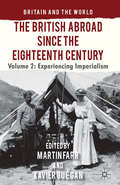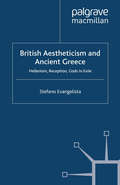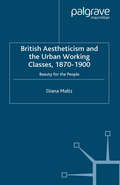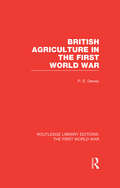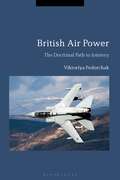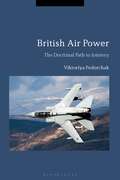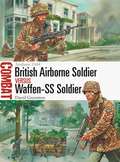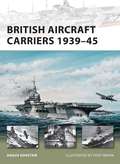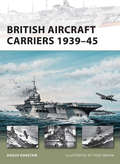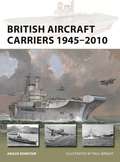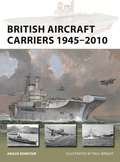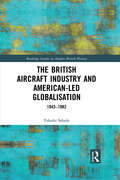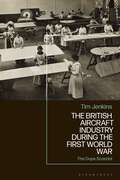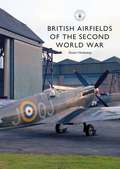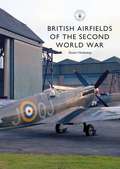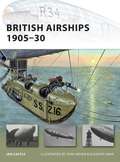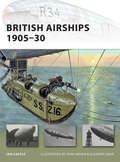- Table View
- List View
The British Abroad Since the Eighteenth Century, Volume 1: Travellers and Tourists (Britain and the World)
by Xavier GuéganThis book considers the British travelling beyond their isles over the last three hundred years, and through a range of interdisciplinary perspectives reflects on their taste for discovery and self-discovery both through the exploration – and exploitation – of other lands and peoples.
The British Abroad Since the Eighteenth Century, Volume 2: Experiencing Imperialism (Britain and the World)
by Xavier GuéganThis is a collection of twelve interdisciplinary essays from international scholars concerned with examining the British experience of Empire since the eighteenth century. It considers themes such as national identity, modernity, culture, social class, diplomacy, consumerism, gender, postcolonialism, and perceptions of Britain's place in the world.
British Aestheticism and Ancient Greece: Hellenism, Reception, Gods in Exile (Palgrave Studies in Nineteenth-Century Writing and Culture)
by S. EvangelistaThis book is the first comprehensive study of the reception of classical Greece among English aesthetic writers of the nineteenth century. By exploring this history of reception, it aims to give readers a new and fuller understanding of literary aestheticism, its intellectual contexts, and its challenges to mainstream Victorian culture.
British Aestheticism and the Urban Working Classes, 1870-1900: Beauty for the People (Palgrave Studies in Nineteenth-Century Writing and Culture)
by D. MaltzThis cultural study reveals the interdependence between British Aestheticism and late-Victorian social-reform movements. Following their mentor John Ruskin who believed in art's power to civilize the poor, cultural philanthropists promulgated a Religion of Beauty as they advocated practical schemes for tenement reform, university-settlement education, Sunday museum opening, and High Anglican revival. Although subject to novelist's ambivalent, even satirical, representations, missionary aesthetes nevertheless constituted an influential social network, imbuing fin-de-siecle artistic communities with political purpose and political lobbies with aesthetic sensibility.
British Agriculture in the First World War (Routledge Library Editions: The First World War)
by Peter DeweyThis volume comprehensively describes how British farmers coped with the problems of shortage of labour and other factors of production, as well as assessing how well agriculture performed as a supplier of food to the nation. Use of previously neglected records provides much evidence on issues such as the deployment of substitute labour and the introduction of the tractor into British farming for the first time. Challenging accepted view on the period, the author shows that shortages of labour and other factors of production had only a slight effect on farm output and the national food supply.
British Agriculture in the First World War (Routledge Library Editions: The First World War)
by Peter DeweyThis volume comprehensively describes how British farmers coped with the problems of shortage of labour and other factors of production, as well as assessing how well agriculture performed as a supplier of food to the nation. Use of previously neglected records provides much evidence on issues such as the deployment of substitute labour and the introduction of the tractor into British farming for the first time. Challenging accepted view on the period, the author shows that shortages of labour and other factors of production had only a slight effect on farm output and the national food supply.
British Air Power: The Doctrinal Path to Jointery
by Viktoriya FedorchakBritish Air Power demonstrates how the Royal Air Force sought to adapt in regard to the roles it could play and the conflicts in which it could be used, as well as the evolution of air power doctrine at a time of rapid changes in national politics and in the international arena. The development of new concepts and theories, the evaluation of operational experience, the political environment and budgetary cuts, and the role of academics and personalities in development of doctrine are thus all explored to show changes in strategic thinking regarding air power.Fedorchak further examines the influence of jointery – the process of co-operation between the army, navy and air force – on thinking, conceptualising, teaching and using air power in recent operations in Afghanistan, Iraq, Libya and Syria. A contemporary complement to more historical studies, British Air Power provides a very detailed look at the development of air-land doctrine in the RAF since the turn of the century.
British Air Power: The Doctrinal Path to Jointery
by Viktoriya FedorchakBritish Air Power demonstrates how the Royal Air Force sought to adapt in regard to the roles it could play and the conflicts in which it could be used, as well as the evolution of air power doctrine at a time of rapid changes in national politics and in the international arena. The development of new concepts and theories, the evaluation of operational experience, the political environment and budgetary cuts, and the role of academics and personalities in development of doctrine are thus all explored to show changes in strategic thinking regarding air power.Fedorchak further examines the influence of jointery – the process of co-operation between the army, navy and air force – on thinking, conceptualising, teaching and using air power in recent operations in Afghanistan, Iraq, Libya and Syria. A contemporary complement to more historical studies, British Air Power provides a very detailed look at the development of air-land doctrine in the RAF since the turn of the century.
British Airborne Soldier vs Waffen-SS Soldier: Arnhem 1944 (Combat)
by David GreentreeOperation Market Garden was an Allied plan to try and end the war before the end of 1944, and relied on landing airborne troops to secure bridges over the Rhine bridges in the Netherlands. Critical to this plan were the glider troops of Britain's 1st Airlanding Brigade. Short on heavy weapons and not trained in street fighting, the glider troops were meant to secure and defend the Allied perimeter around Arnhem as the parachute brigades fought their way into the city. Facing the airborne forces were understrength Waffen-SS units that were hastily formed into ad hoc battle groups, some supported by armour. The troops on both sides would have their tactical flexibility and powers of endurance tested to the limit in the bitter actions that ensued. Employing first-hand accounts and drawing upon the latest research, David Greentree tells the story of the glider troops' dogged defence of the Allied perimeter at Arnhem, and the Waffen-SS forces' efforts to overcome them.
British Airborne Soldier vs Waffen-SS Soldier: Arnhem 1944 (Combat)
by David GreentreeOperation Market Garden was an Allied plan to try and end the war before the end of 1944, and relied on landing airborne troops to secure bridges over the Rhine bridges in the Netherlands. Critical to this plan were the glider troops of Britain's 1st Airlanding Brigade. Short on heavy weapons and not trained in street fighting, the glider troops were meant to secure and defend the Allied perimeter around Arnhem as the parachute brigades fought their way into the city. Facing the airborne forces were understrength Waffen-SS units that were hastily formed into ad hoc battle groups, some supported by armour. The troops on both sides would have their tactical flexibility and powers of endurance tested to the limit in the bitter actions that ensued. Employing first-hand accounts and drawing upon the latest research, David Greentree tells the story of the glider troops' dogged defence of the Allied perimeter at Arnhem, and the Waffen-SS forces' efforts to overcome them.
British Aircraft Carriers 1939–45 (New Vanguard)
by Tony Bryan Angus KonstamWith war against Germany looming, Britain pushed forward its carrier program in the late 1930s. In 1938, the Royal Navy launched the HMS Ark Royal, its first-ever purpose-built aircraft carrier. This was quickly followed by others, including the highly-successful Illustrious class. Smaller and tougher than their American cousins, the British carriers were designed to fight in the tight confines of the North Sea and the Mediterranean. Over the next six years, these carriers battled the Axis powers in every theatre, attacking Italian naval bases, hunting the Bismark, and even joining the fight in the Pacific. This book tells the story of the small, but resilient, carriers and the crucial role they played in the British war effort.
British Aircraft Carriers 1939–45 (New Vanguard #168)
by Tony Bryan Angus KonstamWith war against Germany looming, Britain pushed forward its carrier program in the late 1930s. In 1938, the Royal Navy launched the HMS Ark Royal, its first-ever purpose-built aircraft carrier. This was quickly followed by others, including the highly-successful Illustrious class. Smaller and tougher than their American cousins, the British carriers were designed to fight in the tight confines of the North Sea and the Mediterranean. Over the next six years, these carriers battled the Axis powers in every theatre, attacking Italian naval bases, hunting the Bismark, and even joining the fight in the Pacific. This book tells the story of the small, but resilient, carriers and the crucial role they played in the British war effort.
British Aircraft Carriers 1945–2010 (New Vanguard)
by Angus KonstamThe history of the Royal Navy flagships that led the fleet through the Cold War, ensured victory in the Falklands War, and saw action in Iraq and the Balkans.In 1945, at the end of World War II, the Royal Navy's carrier fleet proved essential to the post-war world. Royal Navy carriers fought in the Korean War with the UN fleet, in the debacle at Suez, and in British operations in the last days of Empire, in Malaya, Borneo and Aden. But most famously, they were the key to the Royal Navy's victory in the Falklands campaign, and they went on to fight in the two Iraq wars.Illustrated throughout with new profiles of the key carriers and their development, as well as a cutaway of HMS Victorious and superb new illustrations of the carriers in action, this book explains how the Royal Navy's air power changed throughout the Cold War and beyond. Renowned naval historian Angus Konstam explains how the World War II carriers were rebuilt in a pioneering modernization that allowed them to operate a new generation of naval jets. As carriers became more expensive to operate, the Royal Navy had to scrap its conventional fast jets and introduce a new generation of light carriers designed for the innovative Harrier 'jump jet'. When the Falklands War broke out, it was one of these new carriers and one veteran carrier from World War II that gave the Task Force the fighters it needed to defend itself in hostile waters and retake the islands.Covering a period of dramatic change for the Royal Navy, this book is a history of the Royal Navy's most important ships throughout the Cold War, the retreat from Empire, and the Falklands and Iraq wars, up to the moment Royal Navy fixed-wing air power was temporarily axed in 2010.
British Aircraft Carriers 1945–2010 (New Vanguard)
by Angus KonstamThe history of the Royal Navy flagships that led the fleet through the Cold War, ensured victory in the Falklands War, and saw action in Iraq and the Balkans.In 1945, at the end of World War II, the Royal Navy's carrier fleet proved essential to the post-war world. Royal Navy carriers fought in the Korean War with the UN fleet, in the debacle at Suez, and in British operations in the last days of Empire, in Malaya, Borneo and Aden. But most famously, they were the key to the Royal Navy's victory in the Falklands campaign, and they went on to fight in the two Iraq wars.Illustrated throughout with new profiles of the key carriers and their development, as well as a cutaway of HMS Victorious and superb new illustrations of the carriers in action, this book explains how the Royal Navy's air power changed throughout the Cold War and beyond. Renowned naval historian Angus Konstam explains how the World War II carriers were rebuilt in a pioneering modernization that allowed them to operate a new generation of naval jets. As carriers became more expensive to operate, the Royal Navy had to scrap its conventional fast jets and introduce a new generation of light carriers designed for the innovative Harrier 'jump jet'. When the Falklands War broke out, it was one of these new carriers and one veteran carrier from World War II that gave the Task Force the fighters it needed to defend itself in hostile waters and retake the islands.Covering a period of dramatic change for the Royal Navy, this book is a history of the Royal Navy's most important ships throughout the Cold War, the retreat from Empire, and the Falklands and Iraq wars, up to the moment Royal Navy fixed-wing air power was temporarily axed in 2010.
The British Aircraft Industry and American-led Globalisation: 1943-1982 (Routledge Studies in Modern British History)
by Takeshi SakadeSakade challenges the narrative that the focus of British manufacturing went "from Empire to Europe" and argues rather that, following the Second World War, the key relationship was in fact trans-Atlantic. There is a commonly accepted belief that, during the twentieth century, British manufacturing declined irreparably, that Britain lost its industrial hegemony. But this is too simplistic. In fact, in the decades after 1945, Britain staked out a new role for itself as a key participant in a US-led process of globalisation. Far from becoming merely a European player, the UK actually managed to preserve a key share in a global market, and the British defence industry was, to a large extent, successfully rehabilitated. Sakade returns to the original scholarly parameters of the decline controversy, and especially questions around post-war decline in the fields of high technology and the national defence industrial base. Using the case of the strategically critical military and civil aircraft industry, he argues that British industry remained relatively robust. A valuable read for historians of British aviation and more widely of 20th century British Industry.
The British Aircraft Industry and American-led Globalisation: 1943-1982 (Routledge Studies in Modern British History)
by Takeshi SakadeSakade challenges the narrative that the focus of British manufacturing went "from Empire to Europe" and argues rather that, following the Second World War, the key relationship was in fact trans-Atlantic. There is a commonly accepted belief that, during the twentieth century, British manufacturing declined irreparably, that Britain lost its industrial hegemony. But this is too simplistic. In fact, in the decades after 1945, Britain staked out a new role for itself as a key participant in a US-led process of globalisation. Far from becoming merely a European player, the UK actually managed to preserve a key share in a global market, and the British defence industry was, to a large extent, successfully rehabilitated. Sakade returns to the original scholarly parameters of the decline controversy, and especially questions around post-war decline in the fields of high technology and the national defence industrial base. Using the case of the strategically critical military and civil aircraft industry, he argues that British industry remained relatively robust. A valuable read for historians of British aviation and more widely of 20th century British Industry.
The British Aircraft Industry during the First World War: The Dope Scandal
by Dr Tim JenkinsIn this book, Tim Jenkins examines the factory worker poisonings and suspect government procurement procedures that resulted in Allied success in the air during First World War.The early development of aircraft during World War I was an important yet dangerous part of the war effort seen in the First World War and although many descriptions of daring aerial combat have been written, the risk to those involved in the manufacture of such machines remains less well known. Tetrachlorethane, a poisonous solvent contained in aircraft dope, was responsible for a number of civilian deaths in aircraft factories and although the British knew the substance to be lethal, they were much slower than their American and German counterparts in sourcing alternatives. In this groundbreaking book, Tim Jenkins explores the use of Tetrachlorethan and brings to light the concerns and warnings voiced by the international medical profession. His examination considers the government's reasons for its use of the poisonous solvent to create a compelling yet scholarly account which takes in corruption, negligence and wartime manufacture. This book will be vital to scholars studying military production during the First World War.
The British Aircraft Industry during the First World War: The Dope Scandal
by Dr Tim JenkinsIn this book, Tim Jenkins examines the factory worker poisonings and suspect government procurement procedures that resulted in Allied success in the air during First World War.The early development of aircraft during World War I was an important yet dangerous part of the war effort seen in the First World War and although many descriptions of daring aerial combat have been written, the risk to those involved in the manufacture of such machines remains less well known. Tetrachlorethane, a poisonous solvent contained in aircraft dope, was responsible for a number of civilian deaths in aircraft factories and although the British knew the substance to be lethal, they were much slower than their American and German counterparts in sourcing alternatives. In this groundbreaking book, Tim Jenkins explores the use of Tetrachlorethan and brings to light the concerns and warnings voiced by the international medical profession. His examination considers the government's reasons for its use of the poisonous solvent to create a compelling yet scholarly account which takes in corruption, negligence and wartime manufacture. This book will be vital to scholars studying military production during the First World War.
British Airfields of the Second World War (Shire Library)
by Stuart HadawayThe Second World War airfields peppered around Britain are among the most visible and widespread reminders of this devastating conflict. Some are now almost forgotten or built over; others have become museums, industrial estates or parkland; and some have been adapted and remain in operation today. In this beautifully illustrated history, aviation historian Stuart Hadaway explains the crucial part airfields played between 1939 and 1945, detailing their construction and expansion; their facilities and equipment; the many functions they housed from command and control to maintenance and bomb-loading; how the airfields were used both for defence and offence; and how they changed during the war. He also explores what life was like on the airfields, as well as listing some of the remaining sites and what can be seen today.
British Airfields of the Second World War (Shire Library)
by Stuart HadawayThe Second World War airfields peppered around Britain are among the most visible and widespread reminders of this devastating conflict. Some are now almost forgotten or built over; others have become museums, industrial estates or parkland; and some have been adapted and remain in operation today. In this beautifully illustrated history, aviation historian Stuart Hadaway explains the crucial part airfields played between 1939 and 1945, detailing their construction and expansion; their facilities and equipment; the many functions they housed from command and control to maintenance and bomb-loading; how the airfields were used both for defence and offence; and how they changed during the war. He also explores what life was like on the airfields, as well as listing some of the remaining sites and what can be seen today.
British Airships 1905–30 (New Vanguard)
by Tony Bryan Ian CastleThis book reveals the fascinating story of the cat and mouse duel between the airship and another pioneering form of technology – the submarine during World War 1. Detailed cut-away drawings reveal the design and development of the airship, during and after the war, whilst full-colour illustrations depict the airship in dramatic action shots. A tragic accident in 1930 brought the airship's military service to an end, resulting in a tiny window in which they were used and little acknowledgement over the years. Ian Castle gives deserved attention to an aeronautical wonder that for a short amount of time played a crucial service to the defence of Britain.
British Airships 1905–30 (New Vanguard)
by Tony Bryan Ian CastleThis book reveals the fascinating story of the cat and mouse duel between the airship and another pioneering form of technology – the submarine during World War 1. Detailed cut-away drawings reveal the design and development of the airship, during and after the war, whilst full-colour illustrations depict the airship in dramatic action shots. A tragic accident in 1930 brought the airship's military service to an end, resulting in a tiny window in which they were used and little acknowledgement over the years. Ian Castle gives deserved attention to an aeronautical wonder that for a short amount of time played a crucial service to the defence of Britain.
British America, 1500-1800: Creating Colonies, Imagining an Empire (1st edition)
by Steven SarsonBritish America combines the histories of colonies and empire - usually distinct fields of enquiry - in a sweeping introduction to and interpretation of the British-American New World. This book argues that while settlers created colonies, the early empire remained a largely imaginary construct.Writers, explorers, and colonial proprietors imagined colonies and empire as corporate entities serving various political, religious, and social purposes. Yet, these visions were invariably usurped by settlers who created colonies according to principles of political autonomy and individual independence based on private property, even if the liberties their ideals engendered entailed the extermination and expulsion of Native Americans and the enslavement of Africans. English and then British governments encouraged autonomy by granting colonies as private proprietorships, and then accommodating the settler-led polities that subsequently emerged. When Britain finally imposed a vision of empire from the 1760s, the settlers declared their independence, forcing Britain to consider imperialism as something much more than imaginary. This account examines the way in which the New World was invented and offers a convincing analysis of the loss of the First British Empire.
British America, 1500-1800: Creating Colonies, Imagining an Empire (1st edition) (PDF)
by Steven SarsonBritish America combines the histories of colonies and empire - usually distinct fields of enquiry - in a sweeping introduction to and interpretation of the British-American New World. This book argues that while settlers created colonies, the early empire remained a largely imaginary construct.Writers, explorers, and colonial proprietors imagined colonies and empire as corporate entities serving various political, religious, and social purposes. Yet, these visions were invariably usurped by settlers who created colonies according to principles of political autonomy and individual independence based on private property, even if the liberties their ideals engendered entailed the extermination and expulsion of Native Americans and the enslavement of Africans. English and then British governments encouraged autonomy by granting colonies as private proprietorships, and then accommodating the settler-led polities that subsequently emerged. When Britain finally imposed a vision of empire from the 1760s, the settlers declared their independence, forcing Britain to consider imperialism as something much more than imaginary. This account examines the way in which the New World was invented and offers a convincing analysis of the loss of the First British Empire.

